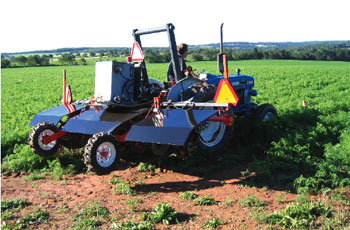
Features
Production
Research
Carrot trimmer taking off
Trimming machines
March 6, 2008 By Dan Woolley
A carrot trimmer developed by Agriculture and Agri-Food Canada
researchers in Charlottetown, P.E.I., has Oxford Frozen Foods’ seal of
approval.
Growers in Nova Scotia and Wisconsin develop their own trimming machines based on AAFC prototype
 |
| The prototype carrot trimmer designed by Dr. Kevin Sanderson and his research team at Agriculture and Agri-Food Canada, based in Charlottetown, P.E.I. Contributed photo |
A carrot trimmer developed by Agriculture and Agri-Food Canada researchers in Charlottetown, P.E.I., has Oxford Frozen Foods’ seal of approval.
The Nova Scotia fruit and vegetable processor has taken the design of the four-row prototype created by Dr. Kevin Sanderson and his AAFC research team and modified it to meet its field production needs.
Angus Ells, Oxford’s carrot farm manager, says his company’s nine-row trimmer achieves the same results, even if it’s different from AAFC’s test machine.
“We took the concept they (AAFC) demonstrated and we developed a machine that would have more output, cover a lot of ground in a day and be low maintenance,” says Ells, adding the company’s Annapolis Valley carrot supervisor, Lloyd Pineo, designed and fabricated Oxford’s unit.
Oxford grows 2,600 acres of carrots on its own lands and those of contract growers in Nova Scotia’s Annapolis Valley and Colchester County, New Brunswick’s Kent County and across P.E.I.
“We do a lot of custom work for our growers,” says Ells. “Our contract growers in Colchester and the valley have really embraced this technology to the point our plans are to build another nine-row unit for next summer (2008).”
Dr. Sanderson’s goal was to design a machine to reduce Sclerotinia sclerotiorum, a fungal disease that has no pesticide controls, notes Ells. “We have seen a tremendous reduction in Sclerotinia. We have also seen a reduction in bacterial soft rot and there are no controls for soft rot. We now have a viable control for that.”
Leaf blight is another fungal disease in carrots that has to be controlled every year, he says. “We found this year (2007), after we trimmed the field, a significant reduction in leaf blight to the point we saw a 25 to 35 per cent reduction in fungicide use.
“On Sclerotinia, we had an 80 per cent reduction in fungicides. Next year, it
will be a 100 per cent reduction with better timing.”
Oxford has reduced both its crop protection costs and its “environmental footprint” with the trimmer, Ells says. “Based on what we have seen, it is going to become an integral part of how we control diseases in carrots.
“We have an IPM program to manage our carrots and this just gives us another good, viable tool for our IPM tool box.”
Ells has also seen that trimming increases harvesting speed and greatly improves the crop’s harvestability.
The trimmer is also a good example of initial basic research evolving into applied technology in the field. In five years, the trimming concept went from a PhD thesis by Dr. Cezarina Kora, to small plot field trials in P.E.I., to demonstration trials with Dr. Sanderson’s trimmer and finally, in the summer of 2007, into commercial field
application in Oxford’s fields.
Dr. Sanderson designed the prototype carrot trimmer with a $25,000 grant provided over two years by the AAFC’s Pest Management Centre.
“Boy, have they ever hit a home run,” says Ells, referring to the federal government’s financial support for the development of the trimmer. “It is a good example of the positive use of public research dollars.”
He was also full of praise for Dr. Sanderson and his research team’s efforts. “Hats off to those guys in Charlottetown. They really did a good job.”
Carrot growers south of the border must also think so. Patrykus Farms in Wisconsin also built a nine-row trimmer during 2007, identical in design to Dr. Sanderson’s trial machine.
Patrykus has 1,000 acres in carrots and their crop adviser informed Dr. Sanderson the trimmer they built was to his design and “functioned exactly as we said it would. It was trimming foliage very well and working fine.”
The American carrot grower contacted Dr. Sanderson about his trimmer after hearing about it from an Ontario contact. Dr. Sanderson forwarded Patrykus Farms information after they indicated they wanted to build the trimmer under licence.
Dr. Sanderson’s machine has received a lot of interest. He presented a paper on the machine during the International Carrot Conference, held in France September 2007. He has also made presentations at the Spring 2007 Muck Crops Conference in Bradford, Ont., and during December 2007’s Horticulture Days in St. Remi, Que.
“We are really optimistic Quebec and Ontario (growers) will be looking at building units,” says Dr. Sanderson. “We believe there will be a lot of benefits besides Sclerotinia control.” ❦
Print this page